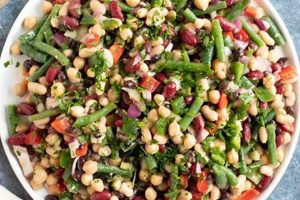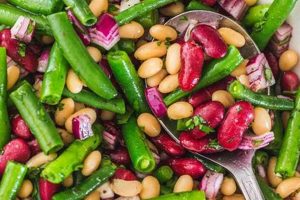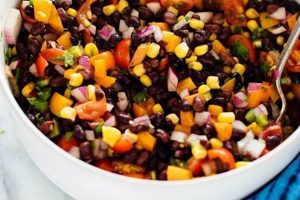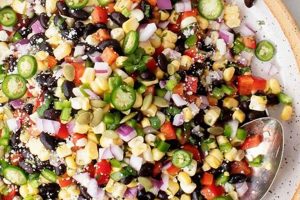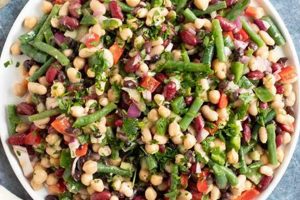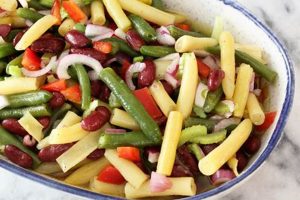Combinations of legumes, such as kidney, black, or pinto beans, with sweetcorn kernels form the foundation of versatile salads. These salads can incorporate a wide array of other ingredients, including diced bell peppers, red onion, tomatoes, avocado, and fresh herbs like cilantro or parsley. A simple vinaigrette, often featuring lime juice, olive oil, and seasonings, typically binds the ingredients together.
These dishes offer a nutritious and refreshing meal option. Legumes provide a substantial source of protein and fiber, contributing to satiety and digestive health. Corn adds natural sweetness and carbohydrates for energy. The inclusion of fresh vegetables further enhances the nutritional profile with vitamins, minerals, and antioxidants. Such salads are adaptable to various dietary needs, easily modified for vegan, vegetarian, or gluten-free diets. They are also convenient for meal prepping or potlucks, holding their flavor and texture well.
This exploration will delve into diverse variations, from simple, everyday preparations to more elaborate presentations suitable for special occasions. Practical guidance on ingredient selection, preparation techniques, and dressing options will be provided. Furthermore, the adaptability of these salads to diverse culinary traditions and palates will be highlighted.
Tips for Crafting Exceptional Bean and Corn Salads
Optimizing ingredient selection and preparation techniques elevates these salads from simple to extraordinary. Attention to detail ensures a harmonious blend of flavors and textures.
Tip 1: Bean Selection and Preparation: Canned beans offer convenience; however, dried beans, cooked from scratch, provide superior flavor and texture. Soaking dried beans overnight reduces cooking time and improves digestibility.
Tip 2: Corn Choices: Fresh, frozen, or canned corn kernels can be utilized. Fresh corn, when in season, offers the sweetest, most vibrant flavor. Frozen corn provides a convenient alternative, while canned corn should be thoroughly rinsed to remove excess sodium.
Tip 3: Balancing Flavor Profiles: Acidic elements, such as lime juice or vinegar, brighten the overall flavor and complement the sweetness of the corn. A touch of heat, from diced jalapeos or a pinch of chili powder, adds complexity.
Tip 4: Textural Variety: Incorporating ingredients with contrasting textures creates a more engaging culinary experience. Crispy bell peppers, creamy avocado, and juicy tomatoes provide textural counterpoints to the beans and corn.
Tip 5: Dressing Considerations: A light vinaigrette enhances the salad without overpowering the delicate flavors of the primary ingredients. Olive oil, combined with lime or lemon juice, forms a classic base. Experimenting with herbs and spices further customizes the dressing.
Tip 6: Enhancing Visual Appeal: A vibrant presentation elevates the dining experience. Colorful ingredients, such as red onion, bell peppers of varying hues, and fresh herbs, create visual interest.
Tip 7: Proper Storage: Storing the salad and dressing separately prevents the vegetables from becoming soggy. Combine just before serving to maintain optimal texture and flavor.
Adherence to these guidelines ensures a flavorful, nutritious, and visually appealing salad. Careful consideration of these elements elevates a simple combination of beans and corn to a truly satisfying culinary creation.
By understanding these fundamental principles, one can confidently create a diverse range of bean and corn salads tailored to individual preferences and dietary needs.
1. Ingredient Selection
Ingredient selection significantly impacts the final flavor profile, texture, and nutritional value of bean and corn salads. Careful consideration of each component ensures a balanced and satisfying culinary experience. Selecting high-quality, fresh ingredients elevates the salad from simple to exceptional.
- Beans:
A variety of beans, each with unique flavor profiles and textures, can be incorporated. Black beans offer a robust, earthy flavor, while kidney beans provide a creamy texture. Pinto beans, with their mild taste, serve as a versatile base, readily absorbing the flavors of the accompanying ingredients. The choice of bean influences the overall taste and nutritional content of the salad.
- Corn:
Fresh, frozen, or canned corn can be utilized. Fresh corn, when in season, offers peak sweetness and a crisp texture. Frozen corn provides a convenient year-round option, maintaining good flavor and texture when thawed properly. Canned corn, while readily available, often contains added sodium and may have a softer texture. The type of corn selected impacts the overall sweetness and texture of the final dish.
- Vegetables:
Beyond beans and corn, a range of fresh vegetables complements the salad. Diced bell peppers, red onion, and tomatoes introduce contrasting textures and vibrant colors. Avocado adds creaminess and healthy fats. Jalapeos or other chili peppers contribute heat and complexity. The selection of additional vegetables enhances the nutritional value and adds depth of flavor.
- Herbs and Spices:
Fresh herbs, such as cilantro, parsley, or chives, brighten the flavor profile. Dried spices, including cumin, chili powder, or oregano, add depth and complexity. The careful use of herbs and spices creates a well-balanced and flavorful salad. The balance of herbs and spices complements the other ingredients, creating a cohesive flavor profile.
Thoughtful ingredient selection enhances the sensory experience and nutritional value of the final salad. Harmonizing the flavors and textures of the various components creates a cohesive and satisfying dish. The interplay of these elements elevates the salad beyond a simple combination of ingredients, demonstrating the impact of thoughtful ingredient selection.
2. Flavor Combinations
Flavor combinations play a crucial role in the success of bean and corn salads. The inherent sweetness of corn and the earthy notes of beans provide a versatile foundation for a wide range of flavor profiles. Strategic combinations enhance these inherent qualities, creating a balanced and nuanced culinary experience. The interplay of sweet, savory, spicy, acidic, and herbaceous elements determines the overall character of the salad.
A classic example utilizes the bright acidity of lime juice to balance the sweetness of corn. Cilantro adds a fresh, herbaceous note, while red onion contributes a subtle sharpness. This combination exemplifies a balanced flavor profile, appealing to a broad range of palates. Alternatively, a Southwestern-inspired variation might incorporate cumin, chili powder, and diced jalapeos, creating a more robust and complex flavor profile. Roasted red peppers can introduce a smoky sweetness, while a touch of chipotle powder adds a deeper layer of complexity. The adaptability of beans and corn allows for significant flavor exploration.
Understanding the interplay of these flavors enables the creation of diverse and satisfying salads. Balancing contrasting elements is key to a successful outcome. Too much acidity can overpower the other flavors, while insufficient seasoning can result in a bland dish. Careful consideration of these elements allows for precise flavor control, resulting in a harmonious and well-balanced salad. This understanding of flavor combinations is essential for crafting exceptional bean and corn salads.
3. Textural Contrast
Textural contrast contributes significantly to the enjoyment of bean and corn salads. The inherent textures of beans and cornsmooth and slightly firm, respectivelyprovide a neutral base. Incorporating ingredients with varying textures elevates the sensory experience. This interplay of textures adds complexity and prevents the salad from becoming monotonous. Consider the addition of crisp elements, such as diced bell peppers or chopped celery, to contrast with the softer textures of beans and corn. The resulting textural variation keeps each bite interesting and engaging.
Further textural diversity can be achieved through the inclusion of creamy components, such as avocado or crumbled cheese. These additions provide a smooth counterpoint to the crunchier elements, creating a more balanced and satisfying mouthfeel. Toasted nuts or seeds introduce a welcome element of crispness and nuttiness. Even the choice of cornwhether fresh off the cob, frozen, or cannedinfluences the overall texture. For instance, a salad featuring grilled corn kernels offers a charred, smoky flavor alongside a slightly chewy texture, distinct from the plumpness of fresh or frozen kernels. The interplay of these varying textures creates a dynamic and engaging culinary experience.
Achieving optimal textural contrast relies on thoughtful ingredient selection and preparation techniques. Dicing vegetables uniformly ensures even distribution of textures throughout the salad. Furthermore, understanding the impact of cooking methods on texture is crucial. Overcooked vegetables lose their crispness, diminishing the intended textural variation. Properly prepared ingredients, combined with an understanding of textural interplay, result in a more enjoyable and satisfying bean and corn salad. This attention to textural detail elevates the dish from simple to sophisticated.
4. Dressing Choice
Dressing choice significantly influences the overall flavor profile and enjoyment of bean and corn salads. The dressing serves not only to bind the ingredients together but also to enhance and complement their inherent flavors. A well-chosen dressing elevates the salad from a simple combination of ingredients to a cohesive and flavorful dish. The interplay between the dressing and the other components is crucial for a balanced and satisfying culinary experience.
- Vinaigrettes:
Light and tangy vinaigrettes are a classic choice for bean and corn salads. A simple vinaigrette, typically made with olive oil, lime or lemon juice, and seasonings, provides a refreshing counterpoint to the sweetness of the corn and the earthiness of the beans. Variations can include the addition of herbs, such as cilantro or parsley, or spices, like cumin or chili powder. The acidity of the vinaigrette brightens the flavors of the other ingredients without overpowering them.
- Creamy Dressings:
Creamy dressings, such as those made with avocado, Greek yogurt, or buttermilk, offer a richer and more decadent alternative to vinaigrettes. These dressings provide a smooth, velvety texture that complements the crunch of fresh vegetables. Avocado-based dressings, for example, offer healthy fats and a subtle creaminess, while Greek yogurt dressings contribute tanginess and protein. The richness of creamy dressings should be balanced against the other flavors in the salad to avoid overpowering the delicate sweetness of the corn.
- Spicy Dressings:
For those who prefer a bolder flavor profile, spicy dressings offer a welcome kick. Chipotle-lime dressings, for example, combine the smoky heat of chipotle peppers with the bright acidity of lime juice. Jalapeo-lime dressings provide a fresher, more vibrant heat. The level of spice can be adjusted to suit individual preferences. It’s important to consider the other flavors in the salad when choosing a spicy dressing, ensuring that the heat complements rather than overwhelms the other ingredients.
- Herb-Based Dressings:
Herb-based dressings highlight the fresh, aromatic qualities of herbs. A cilantro-lime dressing, for example, provides a bright and herbaceous flavor that complements the sweetness of corn. Parsley-lemon dressings offer a lighter, more citrusy note. The choice of herbs can be tailored to complement the other ingredients in the salad. Freshly chopped herbs provide the most vibrant flavor and aroma, elevating the overall sensory experience.
The choice of dressing is integral to the overall success of a bean and corn salad. Careful consideration of the desired flavor profile, the textures of the other ingredients, and the occasion for which the salad is being prepared informs the selection process. A well-chosen dressing harmonizes with the other components, creating a cohesive and satisfying culinary experience. Whether a light vinaigrette, a creamy dressing, a spicy blend, or an herb-infused creation, the dressing serves as the unifying element, transforming individual ingredients into a cohesive and flavorful salad.
5. Presentation
Presentation significantly impacts the perceived appeal and enjoyment of bean and corn salads. While flavor and nutritional value remain paramount, visual appeal enhances the dining experience. Thoughtful presentation elevates these salads from simple meals to visually engaging culinary creations. Consideration of color, texture, arrangement, and serving vessel contributes to an aesthetically pleasing and appetizing presentation.
- Color Palette
Vibrant colors stimulate appetite and create visual interest. Bean and corn salads offer a natural canvas for a diverse color palette. The deep hues of black beans, the bright yellow of corn, and the addition of colorful vegetables like red bell peppers, green cilantro, and red onion create a visually appealing contrast. A monochromatic presentation, focusing on shades of green with ingredients like avocado, lime, and herbs, offers a sophisticated aesthetic.
- Textural Arrangement
Visual texture plays a crucial role in presentation. A mix of smooth, crunchy, and creamy elements enhances visual appeal. Consider layering ingredients to showcase different textures. For example, a base of creamy avocado topped with a vibrant mix of corn, beans, and diced vegetables creates visual depth and textural intrigue. Garnishing with toasted nuts or seeds adds a contrasting element of crunch.
- Serving Vessels
The choice of serving vessel influences the overall presentation. A clear glass bowl showcases the vibrant colors and textures of the salad. Rustic wooden bowls offer a more casual, natural aesthetic. Individual portions in small ramekins or jars create a sense of elegance and portion control. The serving vessel should complement the style of the salad and the occasion.
- Garnishes and Finishing Touches
Garnishes provide the final flourish, adding a pop of color, flavor, or texture. A sprinkle of fresh herbs, a drizzle of olive oil, a scattering of toasted nuts, or a dollop of sour cream or Greek yogurt elevates the visual appeal. These finishing touches demonstrate attention to detail and enhance the overall presentation. Garnishes should complement the existing flavors and textures without overpowering the salad.
Effective presentation enhances the dining experience, making bean and corn salads more appealing and enjoyable. By considering color, texture, serving vessel, and garnishes, these salads transform from simple meals to visually captivating culinary creations. The interplay of these elements elevates the perceived value and enjoyment of the dish, demonstrating the significant impact of thoughtful presentation.
6. Nutritional Value
Bean and corn salads offer significant nutritional value, deriving from the inherent properties of their core ingredients and the potential for incorporating a variety of other nutrient-rich components. Understanding this nutritional profile provides insights into the health benefits associated with regular consumption. These salads can contribute to a balanced diet, providing essential nutrients for overall well-being.
- Protein Source
Beans are a recognized source of plant-based protein, essential for muscle building, tissue repair, and various bodily functions. Different bean varieties offer varying protein content, contributing to the overall protein density of the salad. Combining beans with other protein-rich ingredients, such as quinoa or nuts, further enhances the protein profile. This makes these salads a valuable option for vegetarians, vegans, and individuals seeking to increase their protein intake.
- Fiber Content
Both beans and corn contribute dietary fiber, promoting digestive health and regularity. Fiber aids in satiety, regulating blood sugar levels, and contributing to overall gut health. Including other fiber-rich vegetables, such as bell peppers or leafy greens, further increases the fiber content of the salad. This high fiber content makes these salads beneficial for managing weight and promoting long-term health.
- Vitamins and Minerals
The inclusion of diverse vegetables in bean and corn salads introduces a range of essential vitamins and minerals. Corn provides vitamin C, while beans offer iron and magnesium. The addition of ingredients like bell peppers contributes vitamin A, and leafy greens provide vitamin K. This combination of vitamins and minerals supports various bodily functions, from immune system health to bone strength. The specific vitamin and mineral content varies depending on the chosen ingredients.
- Complex Carbohydrates
Corn serves as a source of complex carbohydrates, providing sustained energy. Unlike simple sugars, complex carbohydrates offer a slower release of energy, preventing blood sugar spikes and promoting sustained energy levels. This makes bean and corn salads a good option for a pre-workout meal or a sustained energy boost throughout the day.
The nutritional composition of bean and corn salads makes them a valuable addition to a balanced diet. The combination of plant-based protein, fiber, vitamins, minerals, and complex carbohydrates contributes to numerous health benefits. Adaptability in ingredient selection allows for customization to address specific dietary needs and preferences, further enhancing the value of these versatile and nutritious salads. By understanding the nutritional components and their respective roles, individuals can maximize the health benefits derived from consuming these salads.
Frequently Asked Questions
This section addresses common inquiries regarding the preparation and enjoyment of bean and corn salads. Clarification on these points aims to facilitate successful culinary endeavors and enhance appreciation for these versatile dishes.
Question 1: What type of beans are best suited for these salads?
A variety of beans complement corn, including black beans, kidney beans, pinto beans, and cannellini beans. Selection depends on individual flavor preferences and desired nutritional profile. Black beans offer a robust flavor, kidney beans a creamy texture, and pinto beans a mild taste that readily absorbs other flavors.
Question 2: Can frozen or canned corn be used as a substitute for fresh corn?
Frozen and canned corn offer convenient alternatives, particularly when fresh corn is unavailable. Frozen corn retains much of the flavor and texture of fresh corn. Canned corn should be rinsed thoroughly to remove excess sodium. However, fresh corn, when in season, offers the most vibrant flavor and texture.
Question 3: How can one prevent a bean and corn salad from becoming watery?
Excess moisture can stem from several sources, including canned ingredients, over-dressing, or insufficient drying of rinsed beans and vegetables. Thoroughly draining and rinsing canned ingredients, using dressings judiciously, and ensuring vegetables are dry before combining prevents excess water accumulation. Storing the dressing separately and combining just before serving also helps maintain optimal texture.
Question 4: What are effective methods for enhancing the flavor profile?
Flavor enhancement can be achieved through various methods. Incorporating fresh herbs, such as cilantro or parsley, adds brightness. Spices like cumin, chili powder, or smoked paprika introduce depth and complexity. Acidity from lime or lemon juice balances sweetness and enhances other flavors. Roasting or grilling vegetables before adding them to the salad imparts a smoky char and intensifies their flavor.
Question 5: How long can a bean and corn salad be stored?
Properly stored, these salads typically last three to five days in the refrigerator. Storing the salad and dressing separately maximizes shelf life and prevents the vegetables from becoming soggy. Ensure the salad is stored in an airtight container to maintain freshness and prevent absorption of other odors.
Question 6: Can these salads be adapted to accommodate various dietary restrictions?
Bean and corn salads are inherently adaptable to various dietary needs. They are naturally gluten-free and can be easily made vegan or vegetarian. Adjustments to the dressing ingredients, such as using maple syrup or agave nectar in place of honey, cater to specific dietary requirements. Ingredient substitutions, like using quinoa instead of couscous, further customize the salad for different dietary restrictions.
Understanding these common points of inquiry provides a solid foundation for successfully creating and enjoying a variety of bean and corn salads. These insights enable culinary exploration and adaptation to individual preferences and dietary needs.
Beyond these frequently asked questions, further exploration of recipe variations and advanced preparation techniques can enhance culinary expertise.
Bean and Corn Salad Recipes
Exploration of bean and corn salad recipes reveals a versatile culinary foundation adaptable to diverse flavor profiles and dietary needs. Careful ingredient selection, from bean variety to complementary vegetables, herbs, and spices, significantly impacts the final product. Balancing flavor combinations, achieving textural contrast, and selecting an appropriate dressing are crucial for a successful outcome. Furthermore, presentation and awareness of nutritional value enhance appreciation for these salads as both aesthetically pleasing and healthful meal options.
The adaptability and inherent nutritional value of bean and corn salads position them as valuable components within a balanced dietary approach. Continued exploration of flavor combinations and ingredient pairings offers opportunities for culinary innovation and personalized gastronomic experiences. Understanding the foundational principles presented herein empowers individuals to create and enjoy these versatile salads, contributing to both culinary satisfaction and nutritional well-being.

